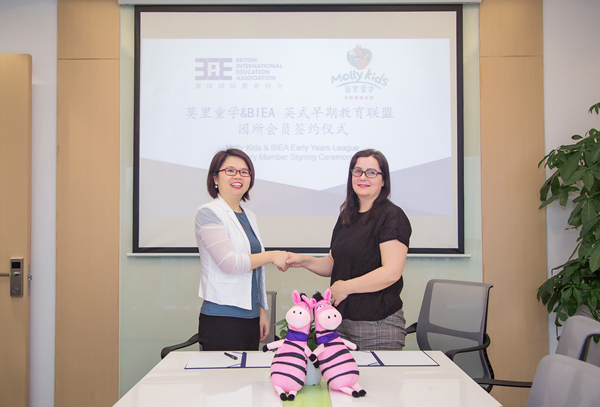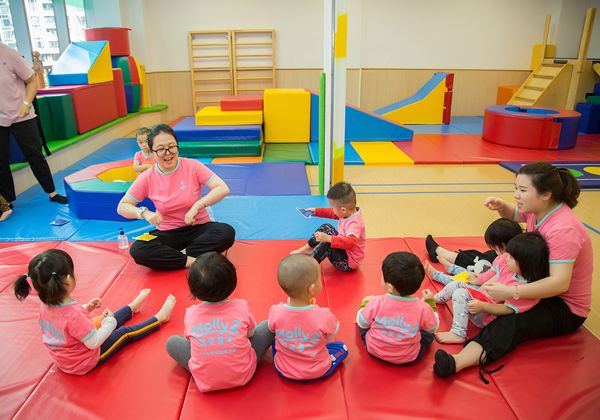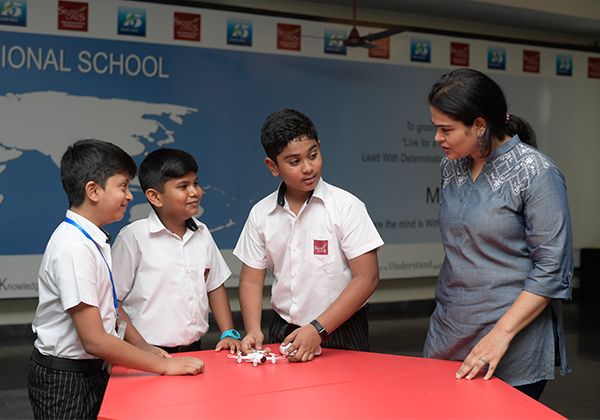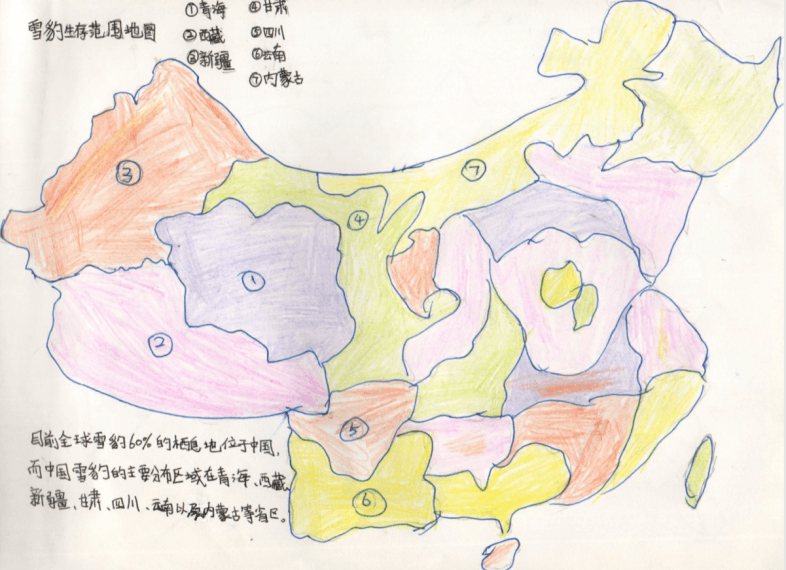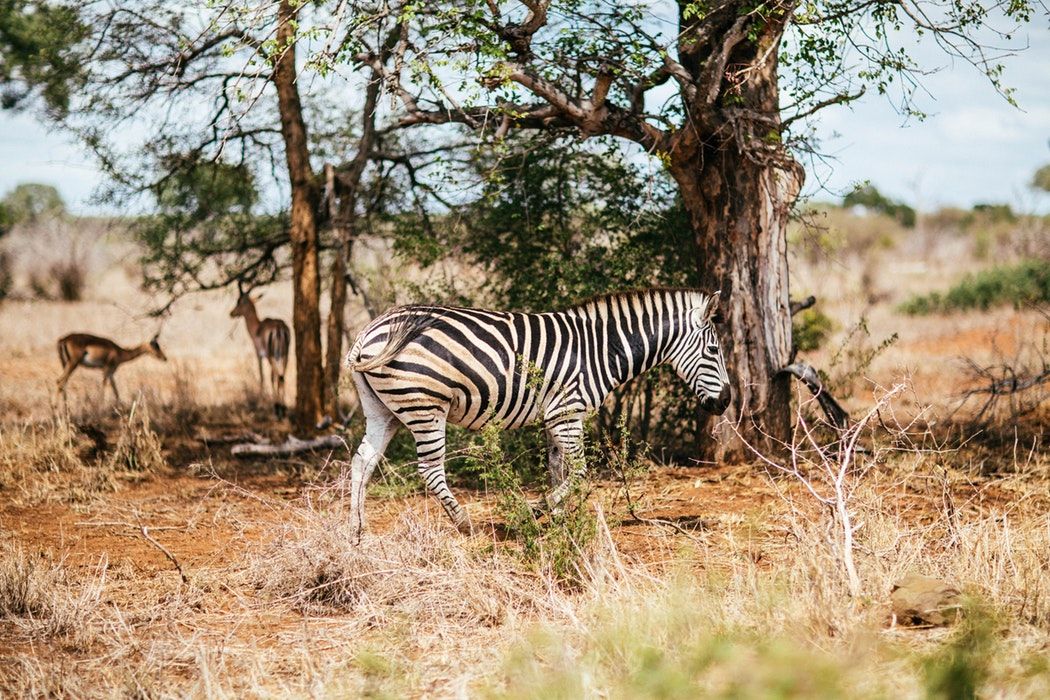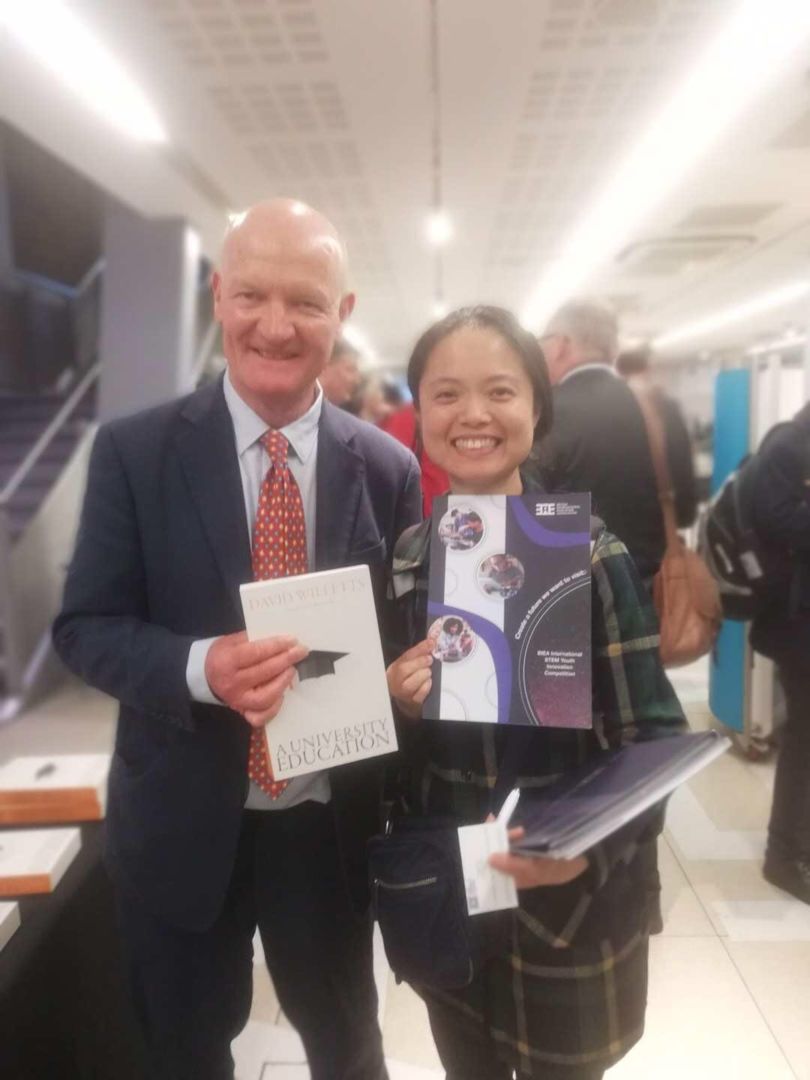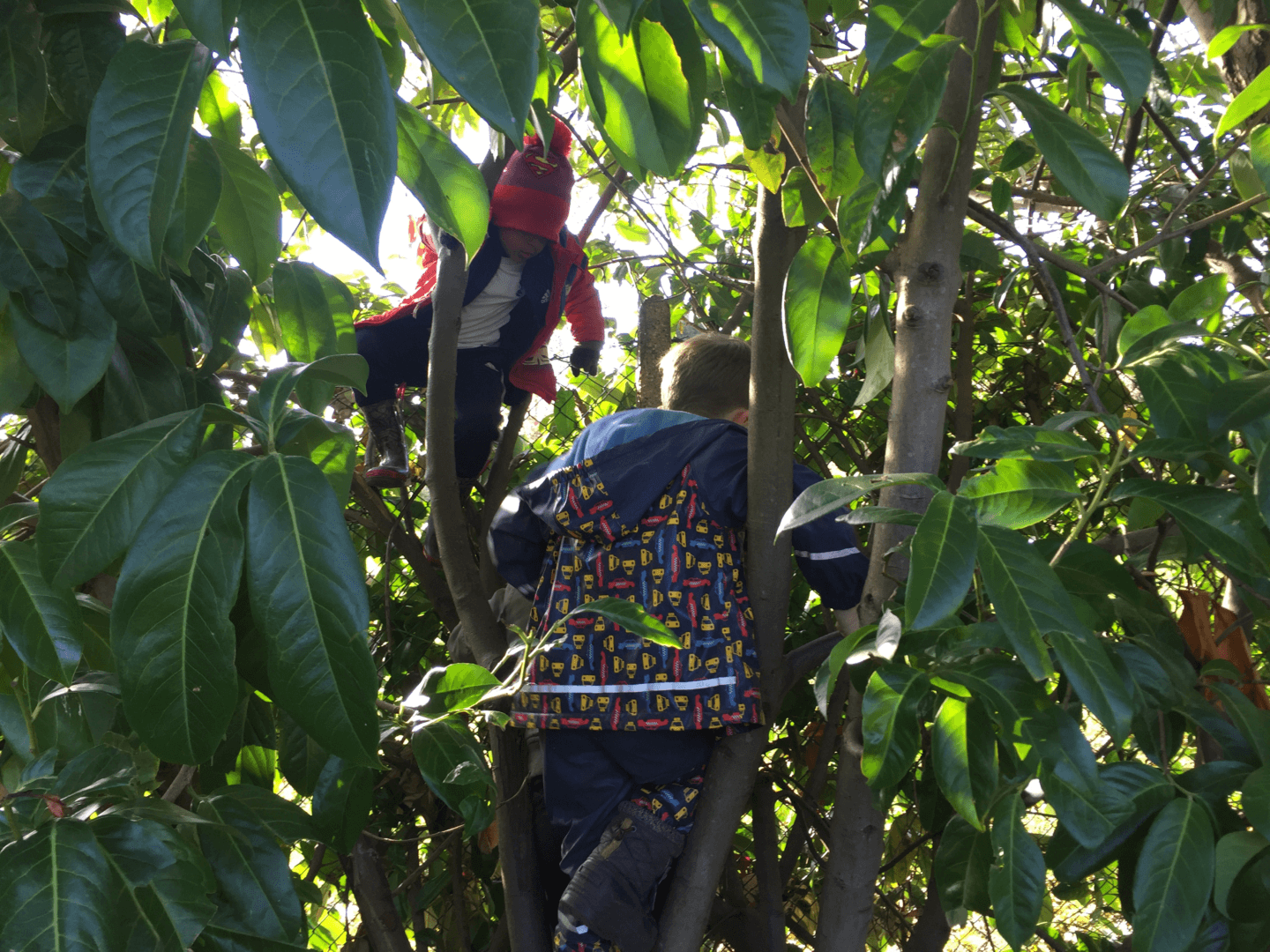Molly Kids School has become the first 0-3 member nursery of BIEA E-League in Guangzhou
In May 2019, Molly Kids officially joined the British E-League of BIEA, becoming a member of the BIEA E-League nursery and the first 0-3 nursery school in Guangzhou.
Molly Kids was founded in 2016. It is an International Day Care Centre implementing the concept of British education. The centre is located in Guangzhou, Yangcheng City. The head of Molly Kid's School of Nursery Studies said that the Centre's focus on children who are happy, confident, thoughtful, physically and mentally healthy, and able to communicate with others was consistent with the UK's EYFS children's development goals, so the centre has always favoured the EYFS system. The BIEA E-League has four core educational resources to solve the EYFS teaching implementation, which is one of the reasons why the centre is determined to become a member of the E-League nurseries.
BIEA E-League (also known as BIEA Early Years League) aims to provide International education practitioners with the best British Early Years Foundation Stage (EYFS) education training and resources, so that children and parents can experience the essence of British education. The four core resources it provides includes: British education’s expert guidance to solve academic problems, British CPD vocational training to solve teacher training problems, cooperative demonstration nurseries to solve practical problems, and British educational institutions to solve teaching support.
It is these excellent and marketable EYFS teaching resources that have attracted the attention of Molly Kids School who pursue high-quality EYFS teaching and are determined to become a member of the E-League family. Under the organisation of E-League, the director of Molly Kids’ education visited British nurseries to study the practice and implementation of EYFS.
As an international day care centre with a keen desire for teaching quality, Molly Kids has a high goal for the quality of the centre. According to the director of the centre, “Although the centre has become the first 0-3 nursery school member of the BIEA E-League in Guangzhou now, looking into the future, Molly Kids School hopes to gradually build the centre into an EYFS nursery school certified through the professional and authentic EYFS teaching resources provided by the E-League.”
The EYFS certification refers to the early education institutions implementing British EYFS courses outside the UK, which can apply for the International British Early Education Certification with International recognition. This means that the nuresry has met the standards for the establishment of British (overseas) International nurseries and the requirements for implementing the British early years education system. BIEA believes that with the support of various E-League resources, Molly Kids, which has passion and faith in education, will realise its dream!
Royal Air Force Museum hosts the final round of the BIEA International STEM Youth Innovation Competition
The 2019 International STEM Competition, organised by the British International Education Association (BIEA), will be held on July 4. For this annual competition of science and innovation, all the staff and expert consultants of BIEA are making every effort to bring the best competition experience to the science and innovation talents that are coming from all over the world. Speaking of which, we have to mention the Royal Air Force Museum, which is the venue of the final round of competition.
The Royal Air Force Museum, as a non-government, public institution, is the only national museum dedicated to the aviation industry in the UK. The museum is made up of six hangers used to display a variety of military aircraft, with over 130 real aircraft distributed throughout the museum, as well as numerous aircraft models, and air force uniforms and souvenirs. The museum designers have cleverly combined the exhibition space with interactive elements to create a unique display space in the exhibition hall. The final of the 2019 BIEA International Youth Science and Innovation Competition will be held in the activity halls located in Hangar Three.
 Aircraft in the royal air force museum
Aircraft in the royal air force museum
According to the organizing committee of the competition, all finalists will compete in groups and draw lots to determine the order of competition. The final competition will be held in three different spaces at the same time: Display space -- used to allow each team to display their design ideas and results; Evaluation space -- the judges will ask questions according to the thesis and video submitted by each team, and all contestants will have an opportunity to reply. Flying space – teams must complete the flight tasks required by the competition in a limited time, this is the ultimate test of the players' flying skills! Judges will be assigned to different spaces, according to their areas of expertise, to mark the competition.
"The final process design not only fully demonstrates the fairness of the competition, but also maximizes the enthusiasm of the participating teams”, said Alex Holmes, designer of the Science and Innovation Competition.
On the day of the final round, teams from all over the world will enjoy a special BIEA award ceremony and a traditional British celebration dinner party after the fierce final competition.
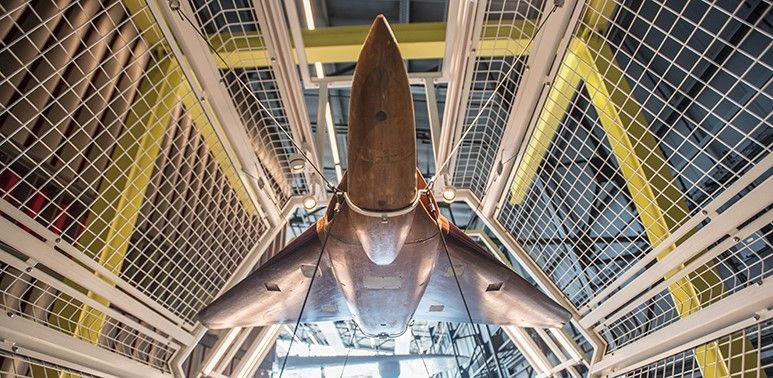 Aircraft in the royal air force museum
Aircraft in the royal air force museum
Vicki, director of external co-operation at the RAF Museum, said, "the RAF Museum has been promoting aviation since it was established in 1972. We not only hope to attract people to come to the Museum who know about airplanes and aviation history, but also hope to create an experience space for teenagers to fully learn about aviation knowledge. This happens to coincide with the theme of 2019 BIEA International Youth Science and Innovation Competition, drone war against species extinction. We are delighted to work with BIEA to bring scientific and creative talent from around the world to the Royal Air Force Museum."
Observe the World Through Science and Innovation
On June the 4th the teams competing in the BIEA International STEM Youth Innovation Competition submitted their video presentations.
Among the many teams submitting very imaginative projects is Chester International School from the UK. Chester International operates a paperless educational approach. All teaching activities are carried out on the student’s laptops and they are equipped with 3-D printers. This encourages enquiry and innovation in STEM disciplines and the BIEA competition is very much something Chester would compete in. The whole team was involved in the project from the beginning and the young woman member concentrated on referencing information regarding the Red Wolf whilst the young men concentrated on the design and construction of the UAV, both cross referencing and liaising where necessary. The team also referenced experts on 3-D technology and design before submitting their project. The BIEA competition was also designed to encourage team ethos and cooperative endeavour which, according to Montana Hull Chester’s teacher and leader has been achieved throughout. Ms Hull said that the spirit of teamwork and cooperation has been evident in Chester’s team since the beginning and especially when considering that they had not done any UAV work previously.
The team from Chester International School was conducting a drone test flight
Topkids Center students were discussing drone transformation ideas
Another school that puts teamwork paramount is Topkids Center in Los Angeles. The USA school has two teams in the finals, one in the 12-14 age group named ‘Paracop’, and the other in the 15-17 group named ‘Zuberi’ Instructor and leader Chris Chai said that when they had first heard of the BIEA STEM Competition and had watched the video of last years competition they had become excited and wanted to enter. He said that it was a great opportunity to apply science and innovative thinking into protection in the real world and that having young students competing with their ideas and technologies from all over the world can only be beneficial to international cooperation and understanding. In selecting which animal to help the teams considered a number of endangered species which included Indiana Bats, iguanas, penguins, Blue-footed Boobies and camels. Eventually the Paracop team chose the Bactrian camel and the Zuberi team went for the African penguin. In preparation for the competition the two teams were encouraged to meet and discuss their respective projects and in this way the elder group gave much help to the younger in terms of technical expertise and flight operation and the younger came up with lots of innovative and interesting suggestions. Teacher Chris Chai offers some advice on how parents can better support their children’s interest in science and innovation, “almost everything around us is tied to science, technology, engineering and math (STEM). Develop your child’s STEM interests by first understanding what areas your child is truly interested in and then taking every opportunity to introduce STEM learning in that area.”
Students were experimenting with whether the transformation plan is feasible
In the process of preparing for the competition, in order to encourage the children to inspire and communicate with each other, the teachers specially let the students of two age groups discuss together. In this way, the higher age group can give a lot of help to the lower age group in terms of technical expertise and flight operation, and the lower age group can come up with a lot of innovative and interesting suggestions.
Teacher Chris Chai also offers some advice on how parents can better support their children's interest in science and innovation: "almost everything around us is tied to science, that area."
Many schools from around the world show exceptional talent and ideas in the BIEA international competition
With the rapid development of science and technology and the pace of globalisation, the requirements for talent in the future world are being constantly refreshed. The concept of STEM education has been around for a substantial time but it has never received the global attention as it does today. With the announcement of the final teams list of the BIEA 2019 International STEM Youth Innovation Competition the international interest in using drone and other modern technology to help preserve endangered species is obvious.
A team from the United World College in Mostar (UWCiM), Bosnia and Herzegovina qualified for the finals in the 15-17 age group. As one of the world's leading IB schools, (offering International Baccalaureate courses), the school entered a team to help protect vultures by using drones to track, observe and understand their life paths and to help solve the problem of vultures that feed on animal carcasses spreading disease and becoming a threat to the ecosystem.
Team from UWCiM was discussing the transformation of drone
The Mostar team transformed the colour of their UAV design and chose to navigate in specific areas only after careful study of the vulture and its habits and referencing expert opinion. Their biggest problem was keeping within budget to realise their ambitions. With help from the BIEA science and technology committee and careful thought into the design of the UAV and the aims of the team a project was submitted that successfully achieved the desired aims of the team.
Team from Silver Oaks International School was exchanging ideas with the instructor Nagashilpa Seethamraju,Coding4kids
India has always been a country that invests heavily in technological development and innovation to encourage economic growth and this is reflected in their educational system. Sunitha Yernagula, Principal of Silver Oaks International School from Visakhapatnam in East India, spoke of the great excitement when the school knew that their team in the 9-11 age group had reached the BIEA competition finals. The team had decided to help Pangolins, which have been hunted for their skins to the point of extinction. The team’s proposed drone design will use programmes developed for python recognition to identify Pangolins in areas inaccessible to humans. The team leader Nagashilpa said that it would be an unforgettable experience for the team to attend the finals in London. She said that the competition provides a platform for students not only to learn technological skills but also to cultivate the idea of using that technology to facilitate animal and environmental protection.
Silver Oaks International School's teammates, their instructor and principals
As well as India and Bosnia and Herzegovina, Sri Lanka has a commitment to science and technology education in its educational system. Gateway College in the capital Colombia has a team that has qualified in the 12-14 age group. Gateway College has a large investment in STEM education and has a specific area dedicated to technological innovation set aside at the centre of the school for that specific purpose. The team decided to help to understand Asian Elephants and developed a drone technology to help count and video their habits. A sophisticated sensor was used in their drone design.
Science and technology education is becoming increasingly important internationally and the more cross national cooperation in this field is encouraged the more it can benefit not only the environment but also the species therein including mankind.
Laura Gosset of The Born Free Foundation and partner in the BIEA International STEM Youth Innovation Competition in 2019 said that it is important for The Born Free Foundation to participate in the event to encourage wildlife conservation. Laura also said that it is a great opportunity to improve children’s science and innovative skills and raise in them an awareness of ecological protection. She also said that any event that publicises the protection of endangered animals at an international level can only be hugely helpful.
Centuries old Grammar School reaches the STEM final. Queen Elizabeth’s School enthusiasm for modern technology
As a country with a long tradition of innovation in science and technical instruction with a long history of STEM education and as the host of BIEA 2019 International STEM Youth Innovation Competition, Britain not only leads the number of participating teams in this competition but also has had a remarkable success in the preliminary rounds of the competition. One of the teams entering the final is Queen Elizabeth’s School in Barnet. The boy’s school was founded in 1573 under a charter granted by Queen Elizabeth the first and today, besides providing the traditional comprehensive education expected of a traditional grammar school, encourages inquiry into unmanned vehicle technology, VEX robotics and other cutting-edge technologies and has won many awards and international competition.
Regarding their interest in the competition the school science and technology department director, Michael Noonan, said that earlier this year one of his students, Aryan Jain, saw the notification of the BIEA international STEM competition whilst browsing the web and very quickly others became interested and a school team was formed to compete.
The teachers were very supportive of the student decision to enter the competition and encouraged them to explore their ideas independently. Michael Noonan said, "From the initial selection of animal species to the creation of the report and to the development of the UAV according to their designs, it was all the result of the team's own little by little exploration and progression."
The team is discussing their drone design
The team members are discussing which animal to choose to help protect. The team drew up a long list of endangered animals and explored the role drones could play in protecting them. As a result of the discussions the team members were enthusiastic to develop glider drones and choose an animal with a large distribution area hence the choice of the Black Rhino.
After referencing the relevant publications the team decided to use military surveillance techniques to aid in the protection of Black Rhinos. A complex equation derivation was successfully used to calculate the pixel resolution in the final design.
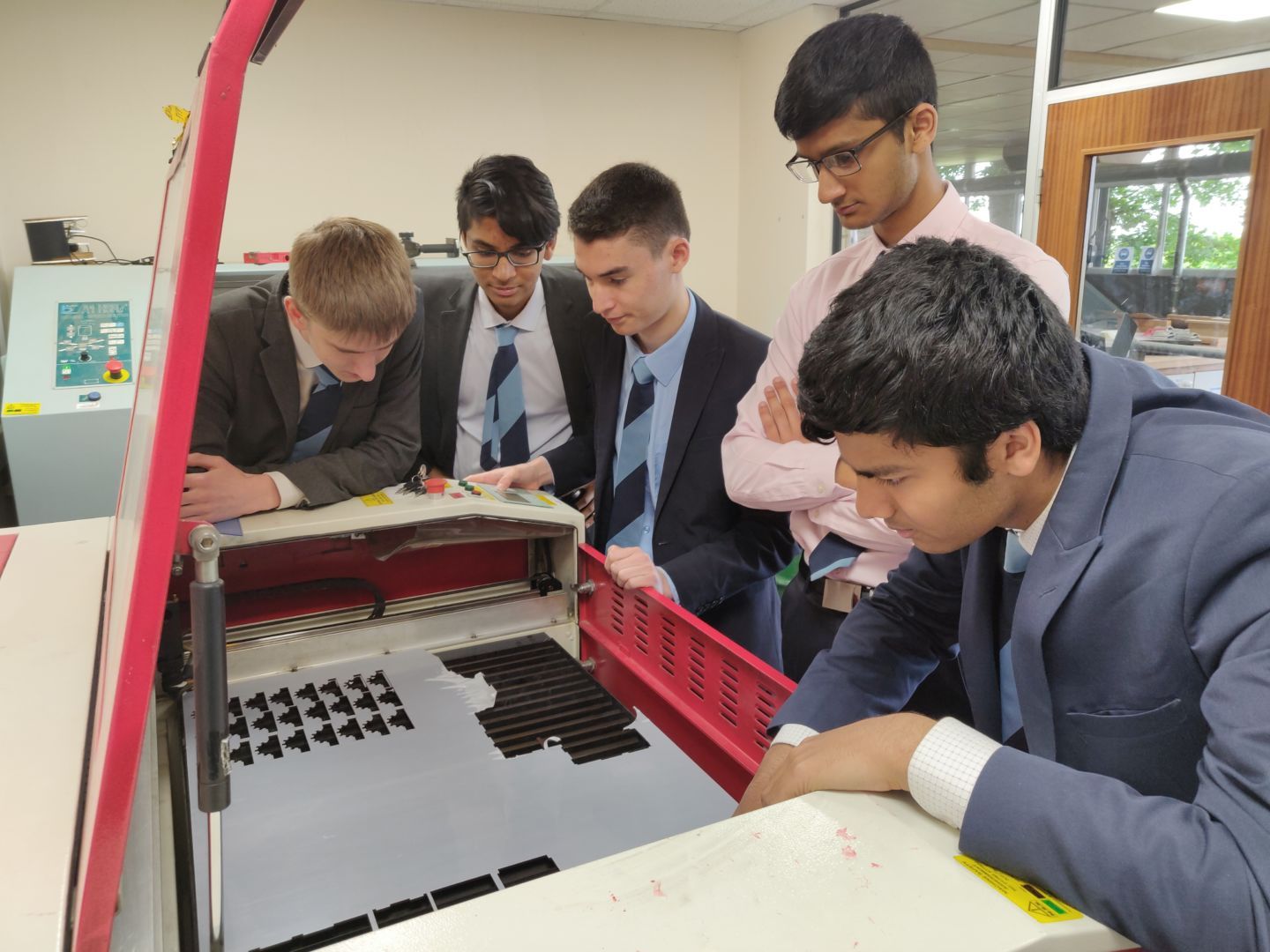 The team is working together to remodel drone parts
The team is working together to remodel drone parts
The final report and submission for the competition final deadline coincided with school examinations. How not to interfere with study for the all-important examinations? The boys were very enthusiastic to enter their drone design in the competition but were as equally concerned to complete their studies for the examinations. To this end a detailed division of work to be done was scheduled to be carried out outside of study time. Two days before the report had to be submitted the team had to work more than 14 hours a day to complete it. The hard work paid off and the report was submitted on time.
Having reached the finals the team was so enthused that they decided to build their drone themselves in order to present their design to the fullest. This has increased the difficulty but is definitely well worth the extra effort.
 Team members are testing the drone design
Team members are testing the drone design
The team were divided into three sections, a group responsible for electronics, another responsible for the video and another responsible for the fuselage. The electronics group focused on providing the power and the control system and system compatibility. The video group made the video submission, wrote scripts, arranged 3D printing and coordinated the budget etc. The fuselage group designed the chassis and structure of the drone – all are coming together to provide the finished entry.
Despite the small number of team members the preparations for the final are proceeding in an orderly manner under the divided group responsibility and with close cooperation. Everyone in the team is looking forward to the science and technology innovation competition finals on July the 4th.
Michael Noonan is extremely proud of his students and the effort that they are putting into the project. When the team found out that they had been selected for the finals the rest of the school was enthused with interest in the BIEA STEM Competition and he believes that more students will show interest and compete in any future competitions.
Scientific innovation inspires youngsters in STEM
With the finalist list announced the BIEA (2019) international youth science and innovation competition the atmosphere continues to intensify with the teams entering the final preparatory stage. The reports submitted in the preliminary contest not only reflect the understanding and cognition of each team of aspects of scientific innovation, but also represents the level that teenagers in different countries and regions have achieved. Being a leader in China’s economic development Shanghai has always attached great importance to science and innovation in education. The four teams sent by the second affiliated middle school of east China University in Shanghai are honoured to have reach the final to be held in London.
Students wholeheartedly embraced the project.
The theme of BIEA (2019) international youth science and technology innovation competition is "drone wars and species extinction". The combination of the popular UAV technology with humane animal protection projects has attracted active participation from schools from around the world. This includes the second affiliated middle school of East China in Shanghai. Due to the large number of students that have enrolled for the project the school selected two teams in the 12-14 age group from the Junior Middle School and one team in that age group and another aged 15-17 from the International Department to participate in the competition.
 Middle school Cavalries group students discuss UAV designs with technology teachers
Middle school Cavalries group students discuss UAV designs with technology teachers
Although they love science and innovation, how to combine drones with animal protection was still a great challenge for the children. Teachers Yang Bing and Chen Giong asked experts from Shanghai Jiao Tong school of aeronautics and astronautics to give advice and help. The International Department and the Agricultural School in the University arranged for the children to visit the drone base of the university to experience examples of the uses of drone technology. This increased the enthusiasm and excitement amongst the children for the competition.
Students from the international department discussed UAE design with Yan Li (second from right) and Qian Feng (fourth from right) their science and technology teachers
Brainpower and hardwork. UAV design fun.
After discussion with teachers and comprehensive research children quickly chose the animals to be protected by their teams and modified the UAV designs according to the environment and habits of the animals selected.
The Typhoon group of students in the Junior Middle School chose the Chinese flying squirrel with multiple teeth as the animal to protect. Because of the nocturnal habits of the flying squirrels the students decided to use a wide-angle camera to observe and locate the caves they inhabit during the day and then use the night vision camera to observe and count the population at night. The advantages and disadvantages of all kinds of equipment were assessed and used to help them complete their objectives.
 Participating students in the Junior Middle School discuss the design of their UAV.
Participating students in the Junior Middle School discuss the design of their UAV.
The UAV Cavalries team, another team from the middle of the primary school, selected the Asian elephant to help protect. They had to consider such things as counting the population, the encroachment of poachers and the availability of water. All of this was considered and researched in creating their project.
The junior high school and senior school teams of the International Department chose snow leopards and Chinese alligators as their animals to help protect. Each carried out comprehensive research on their respective animals and used their spare time to investigate design and construction characteristics of drone technology. The whole experience was very enjoyable.
The challenge was met and all four teams are finalists
The UAV design and modification process greatly facilitated the children's creative thinking as well as their ability to research projects and develop the attendant skills. One of the many things that the students from the International Department’s 15-17 age group team discovered during their research on the Chinese alligator was that it’s skin colour was so close to that of the rocks on which it basked that it was difficult to see and that it was poikilothermic (cold blooded) and could not be tracked by an infrared camera.
To overcome this problem the team researched the habits of the alligators and discovered that they liked to float on the water and that their eyes glowed red when illuminated at night. This enabled the team to devise a method for counting the alligators with their drone.
 Contestants from the International Division team fly drones with their instructors
Contestants from the International Division team fly drones with their instructors
During one of the flights to test the design of the drone near a school pond the sound startled a water bird catching fish and it’s wings knocked the drone. Fortunately, all was not lost and the children guided the drone to a save landing in a large stone in the middle of the pond. Yan Li, a science teacher and innovation instructor at the school was full of praise for the way the children handled the crisis.
 Test flight site contestants are debugging the drone
Test flight site contestants are debugging the drone
The science and technology innovation competition is a perfect opportunity to exercise children's science and technological innovation ideas and practical ability. The competition also allows the children to express their very human instincts in their desire to protect wild animals whilst displaying their innovative and technological skills to others from around the world and experts in STEM education. This can only bode well for the future.
When we found out that our team had been shortlisted for the finals and that we were going to London to participate we all cheered. We are full of pride and are honoured in the mission to compete with other school teams from around the world. I hope that the preparations for the finals that we are making at present will result in a most enjoyable time for all concerned and that Shanghai will prove a worthy competitor in the competition.
Impressive works by students in 2019 BIEA STEM Competition
One of the results of organising this competition, amongst others, is the quality of illustration and drawing exhibited by the school teams across the age groups.
The drawings of the distribution of snow leopards and maps of China submitted by the Hangzhou World Foreign Language school in the 9-11 age group are charming (above). What is equally stunning is the wonderful illustration of a tiger painted drone with a tiger faced centre submitted by Ravenswood School For Girls in the same age group. Their power point report is also very well done.
The photo and reasoning of the drone design submitted by the No. 2 High School of East China Normal University are equally clear in the 15-17 age group.
Many of the drone designs in the older groups are fascinating and ingenious. One submission that stands out technically is from the Koszaline secondary school 1 LO 1m for the preservation of Gray’s Zebra. Their innovative design and technical reasoning is amazing.
The imaginative use of material in construction of the designs was surprising. No 2 School Shanghai’s reasoning for and explanation of using graphene in their drone is very interesting. Queen Elizabeth’s School Barnet’s reasoning for using a fixed wing design is equally impressive in their desire to help the Black Rhino. The clear reasoning and explanation of the design of India’s Visakha Valley School’s drone design including a clever use of Raspberry Pi in the desire to track the Red Panda in it’s environment is fascinating.
Hisar School from Istanbul intriguingly propose to use of mycelium as a material in the construction of their drone designed to assist Mountain Gorillas and Pangolins.
Other finalists have chosen to help complex toothed flying squirrels, basking sharks, tasmanian devils and other endangered animals with their projects and the finals in July look to be a very exciting and rewarding occasion.
A University Education: Engineering in UK Universities
A University Education: Engineering in UK Universities
Lord David was minister for universities and science in the coalition government from 2010 to 2014, when the cap on tuition fees was raised to £9,000 per year in England and Wales. Today he gave a talk at the UCL department of engineering to an audience of higher education professionals including from the UK and abroad on what a modern university education could be, in particular, university education for future engineers. BIEA was invited as a guest among professors from Bath University, Kings College, UCL, etc.
Reflecting on his experience in British politics, Lord Willetts explained the policies and decision-making processes within British government on education.
He also talked about accessibility to university: are there too many graduates in the world? Should everyone go to university? Will there be more 4 year degrees in the future or more students will choose a 2-year degree? There is no clear right or wrong answer in them, the audience was happy to participate in the discussion.
Lord Willette is aptly nicknamed ‘two brains’ for being an intellectual, he strongly believes in evidence-based research and raised questions about recent The longitudinal education outcomes (LEO) Data. This is a UK government publication on employment and earnings outcomes of higher education graduates broken down by subject studied and graduate characteristics. In his opinion, during a recession, a university degree helps with graduate employment, although earnings could be lower. The hardest hit group would be the young people without a degree, as employers in difficult times would choose to pay less for a better-educated workforce.
During the session, international comparisons were made between UK and Germany engineering graduates. Also how collaborative work between universities from the UK and other countries could encourage creative partnerships and benefit the students.
One of the key issues discussed was how British students had to specialize early in their education compared to other countries. At 16 or 17, students in England would need to decide which disciplines they would follow at university, they would then choose three or four subjects at A-levels. Lord Willetts believes that this early specialization gives less breadth of knowledge to students and ultimately limit their choices in future careers.
Also the gender balances in STEM education was raised by several guests, although more girls are now taking Maths at A-levels than ever before, the number pursuing a science degree is still low.
Reflecting on BIEA’s International STEM Competition, we have had a record number of female students joining in the competition and this demonstrates the appeal of the theme to both girls and boys.
We are glad to share updates on the international reach of our competition and we hope Lord Willetts will share his wisdom and wit at the international final on 4th July.
Amazing entries from the first round of the BIEA 2019 STEM Competition
Students from the Coleraine Grammar School in Northern Ireland and their teammates flew their drone with their instructor starting their journey on the BIEA 2019 STEM competition.
BIEA was impressed with the entries submitted for the first round of the competition. It was obvious that many teams had worked hard to thoroughly research, design and write up their ideas for saving animal species from extinction.
The range of animals was impressive, and we were particularly impressed with entries that included animals relevant to the teams’ local area. This included the entry by Coleraine Grammar School on Basking Sharks that had been seen in Irish waters. They followed up their ideas with a visit from a local university lecturer to discuss drones. We were also impressed by Srednja skola Jablanica, a school in Bosnia, who focused on Bosnian wildlife, including the lynx, wolf and mouflon. Their report reflected some excellent planning and well-described division for team roles. Visakha Valley School chose the Red Panda for their project focus, and submitted an outstanding report including details about each of the team members and their supporting staff. One of the teams from Sheffield Park Academy also included details about team member roles in their project on the Tasmanian Devil.
Some teams incorporated innovative ways of experimentation for the report. One of the teams from St. Margaret's School conducted a field test to find out how many pupils (‘animals’) could be counted by their drone at different heights in their project on Darwin Foxes. Team Endeavour, in their report on Sea Turtles, tested the strengths of different materials and measured the thrust of a motor to help determine their final drone specifications.
We also had a lot of teams using CAD and 3D printing to help with drone designs. Topkids Center included an outstanding design specification for their project on the Bactrian Camel. A team from Kent College 3D printed their design from their specifications, as did I Liceum Ogólnokształcące im. St. Dubois, who also developed a flight simulated path for their drone project on Zebra.
Some outstanding hand drawn specifications were also included – we were particularly impressed with the diagram for the Snow Leopard tracking drone by Alpha Preparatory School, along with the detailed exploded diagram of drone by the Westcliff High School for Boys and their project on the Amur Leopard, and the original drone design by the American International School of Cape Town who designed a drone with caterpillar tracks for tracking Savannah wildlife. The team from the Shanghai Foreign Language School Affiliated to SISU included in depth calculations for the drone range using 5G wireless signals around a Tibetan antelope animal reserve.
From nature - back to nature
Last week we visited a very unique after class club called ‘strong roots’. There are many of this kind of after school club in Britain. What is behind the name ‘strong roots’ after school club? We interviewed Suzanne who leads the club and she gave us a surprising yet delightful answer.
The original inspiration for ‘strong roots’ came from Suzanne’s own experiences of seeing children’s paintings and how these were a vehicle for self-expression. She decided on the name after seeing how the children thrived when involved with nature.
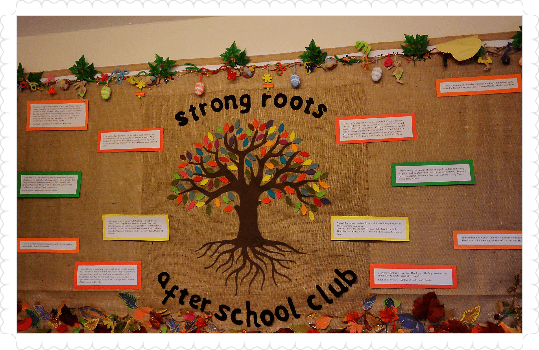
Does your nursery have a display wall (like the one shown above) to describe your "vision and ideas"?
Involving the children in nature the teacher acts only as a guide and the children are given space to freely express their imagination and creativity and to enjoy the aesthetics and magic of nature. In this way it reflects the philosophy of the learning centre’s director - let nature act as the best teacher for the children.
Part of understanding the world

During our visit the staff placed two snails in warm, humid containers and allowed children to become familiar with them and observe their growth. Once the snails had been fed the children are only too eager to tell me what they know about the snails, what they are doing and why snails inhabit the environment that they do.
When a snail enters the model castle (pictured below) Suzanne poses guided questions: "What is this?"she asks. A little boy replies: "This is a snail leaving behind traces…".
Children are encouraged to understand and learn about these fascinating animals through close observation. This is one of the principles of good EYFS practice known as ‘Planning in the moment’. This refers to the process (where no advanced planning is required) whereby a teacher builds on what the child is already doing at that moment and only intervenes to help move their learning forward. These ‘teachable moments’ simultaneously engage children’s curiosity, encourage them to think further and allow them to give short but crucial timely responses to their interests.
1. Movement Skills
Using the educational framework of the seven areas of physical development laid out in EYFS, the nursery has a purpose-built and stable climbing frame with a see-saw to develop children's sports and coordination. Climbing up and down the equipment lets children gain crucial balancing and dexterity skills. It is important to use a variety of artificial equipment together with natural resources to enable children to exercise confidently in various ways. In this way children learn to use space safely. Teachers may want to allow older children to climb trees to certain heights to enjoy sensory exploration of trees through touching and feeling in the fresh air and sunshine.

2. Physical health and self-care ability
We learnt that children gradually become aware of the importance of safe usage of devices and tools between the ages of 30 and 50 months in their development. Teachers also start to work on strengthening children's physical movement and ability during this period so that they can learn to grasp tools and different objects safely and thus steadily improve these skills. They then use these tools when undertaking creative activities.
Exploration and use of media & Materials
Children can make the most of nature - even fallen leaves can become their musical instruments. For them the sound created by blowing grass leaves sounds on occasion, like pigs or like birds, is great fun.* Teachers resourcefully use the shell cuttings of hazelnuts, on the same sound principle as a flute, to teach children how to use airflow to produce a crisp and pleasant sounds.
Featured independent outdoor game
1. Mud kitchen
Let children have full play using their imagination.
Experience the real fun of cooking.
Develop a sense of cooperation and build partnerships.
Exercise small muscles to promote hand-foot co-ordination.
Teachers use natural resources such as soil to stimulate children's imagination. This practice also promotes the principle of environmental protectionism. Some children tell me "I'm making magic potions." Others tell me "I'm making a magic salad." What a lovely and imaginative group!
2. Expedition
Fosters the children's spirit of adventure, discovery and promotes their exploring capabilities.

At one point a young boy tells me excitedly, "Look, this is my base!". So, when they are given a certain degree of freedom children become very good at discovering the secrets of nature. They learn to observe and feel by exploring and the nursery provides ample space to stimulate children's curiosity and go exploring by themselves.
What kind of environment?
Provide an interactive environment.
Design an exhibition area of children’s work for display.
Create an open but secure environment.
Use widely available natural materials.
Allow children free access to all materials.
Real natural materials, safety conscious activities, being mindful of environmental protection.
Low cost, easy to collect multiple-use resources.
Stimulate children's creativity and imagination.
Keep material fresh and stimulate children’s desire to explore.
Here most of the materials used have come from the natural environment and the children use their creative imaginations to inhabit fairy tale kingdoms with their teachers working as their guides. The club teachers are committed to being watchful guardians by simple observation and patience responding to the children’s needs where necessary. They respect the uniqueness of each child, explore ways to establish positive relationships between children and strive to create an interactive and open environment for them. They implement numerous independent outdoor games to achieve core EYFS concepts. We encourage you to create your own natural paradise of play and learning, growth and progress in your nurserie



